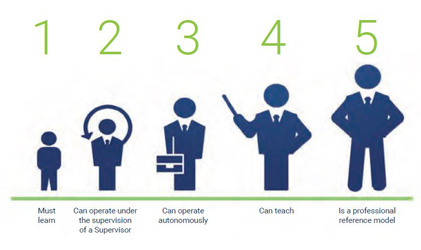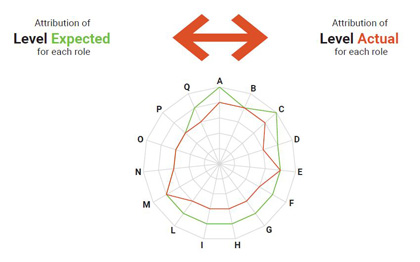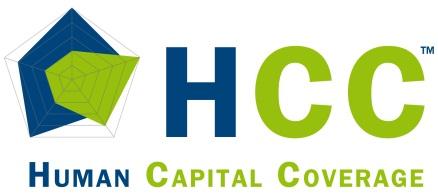Human Capital Coverage
The ERG measurement model for ROI of Human Capital
In recent years we have changed the words and concepts used within our organisation, going from the idea of "Human Resources" to the idea of "Human Capital": we believe that the difference lies primarily in the consideration that a "resource" is "used", whereas "capital" is "corporate wealth", an asset not made up only of a technical - economic component, but also (if not primarily) of the "human" component, our People.

Organisational manuals
In order to concretely develop these concepts and to find a way to measure the "value of Human Capital", we have created tools that are useful first of all for Management and in general for all those who operate within the Group: Organisational Manuals that allow everyone to discern which skills are actually required to best perform their role within the operational context.
The Organisational Manuals, developed for each company in the Group, describe every role defined within the organisation for the performance of its operations.
The manuals identify all the skills required to fully cover each role are identified, with a rating on a scale from 1 to 5 (where 1 is the minimum and 5 is the maximum).
Skill Gap Analysis

The Organisational Manual is developed with reference to each Organisational Unit in the Group (Corporate Unit, Renewables and Power Business Unit, ERG Services), following an identical and standardised conceptual structure based on:
- the specific organisational set up of each organisational unit, concerning the identification of the reported roles;
- a unified and transversal list of skills on a Group level (the "skills catalogue") identified by the Human Capital team in collaboration with the operations management.
The next step was to identify the organisational areas with shortages of the required skills in order to understand where the greatest changes are required and how to implement them. In order to conduct an adequate Skill GAP Analysis, we fine-tuned an internal instrument in line with the skills profile identified in the organisational manuals. The main goal was to compare the "expected" skill level for each position to the "actual" skill level of the people who cover the various roles. The results obtained constitute a dataset that "speaks" in a way that is both shared (in terms of method and content) and objective (through an internal verification process on the quality of the information provided), about the status of role coverage in the various Group Organisational Units, with the possibility of analysing the situation on a single role level or combining the Group data. Some statistics:
- about 600 employees assessed using Skill GAP Analysis,
- 91% of the company population;
- 362 skills identified;
- 147 roles defined.
Human Capital Coverage Index

The database we built and the methodology we fine-tuned make up a very important tool for "managing" Human Capital, allowing the value of our Human Capital to be briefly expressed at any given time. We have defined it as the "Human Capital Coverage" index.
This index represents the "glue" within the Human Capital processes aimed at organisational optimisation and efficiency/effectiveness: it provides us with a SWOT analysis of each area, useful for strategic manpower planning, it guides us within the training, internal mobility and career paths as well as in the allocation of resources based on how profile and role "fit" together, and in the hiring area thanks to the knowledge of the expected profiles as a tool to select the best candidates.
The objective foundation on which is developed allows us to express a numerical value for the return on investment in human capital (considering it as the labour costs in a given year), based on the following formula:

This Human Capital assessment tool of ours is very useful and innovative; to this day, no similar tools can be found amongst methods for personnel and organisation management and development.
This is why we felt that it was appropriate to register the brand (in the assigned classes 9, 35 and 42) with the UIBM (Ufficio Italiano Marchi e Brevetti - Italian Office of Brands and Patents).
In 2020, the need arose to also develop this method abroad. Again this year, we compared our results with those of previous years, and generated important information that will help us improve and enhance the process. In fact, on the basis of the new 2020 initiatives, we determined the training plans we need to close the gaps identified by this indicator, which has now become a fundamental tool for our future programmes.
Key 2020 findings include:
• assessment of the company’s entire population;
• the 421 skills that make up our “skills catalogue”.
In 2020, our HCC index, the “Human Capital Coverage” index, was 94%, up about 1 percentage point compared to 2019 (+4 percentage points compared to 2018, the year the Plan began) in a context that was substantially changed with the OneGroup set-up, and revised organisational criteria.
The main reasons behind this increase are attributable to a few key factors:
• identification of the company’s organisational areas where measures were needed;
• development of organisational processes to improve productivity in certain specific areas;
• updating of training criteria also on the basis of analyses developed with the HCC.
Essentially, the skills development plan involved Process Engineering & Asset Performance, Regulatory & Market Scenario, Business Development & M&A, and Human Capital &ICT.
| Company Employees(1) | Skills identified | HCC Coverage | |
|---|---|---|---|
| 2018 | 100% | 400 | 90% |
| 2019 | 100% | 401 | 93% |
| 2020 | 100% | 421 | 94% |
1 Excluding the first line reporting to the CEO.
(Source: 2020 Sustainability Report - Consolidated Non-Financial Statement drawn up pursuant to Italian Leg. Decree 254/2016 )